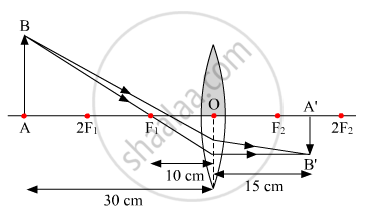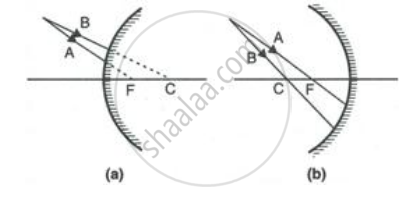Advertisements
Advertisements
Question
One half of a convex lens of focal length 10 cm is covered with a black paper. Can such a lens produce an image of a complete object placed at a distance of 30 cm from the lens? Draw a ray diagram to justify your answer. A 4 cm tall object is placed perpendicular to its principal axis of a convex lens of focal length 20 cm. The distance of the object from the lens is 15 cm. Find the nature, position and the size of the image.
Solution
An image is formed from a number of rays from the object getting refracted by the lens. The complete image will be formed even if one half of the lens is covered. However, the brightness of the image will be less.
Case I: When the upper half of the lens is covered
In this case, rays of light coming from the object get refracted by the lower half of the lens. These rays meet at the other side of the lens to form the image of the given object as shown in the following figure:

Case II: When the lower half of the lens is covered
A convex lens can produce the complete image of the object even though half of the lens is covered. This is because light coming from the object can be refracted from the other half of the lens. However, the intensity of light will be reduced.

Given:-
Height of the object = h = 4 cm
Focal length of the convex lens = f = 20 cm
Object distance = u = −15 cm
Using the lens formula, we get
`1/`
`therefore1/`
`therefore`
Hence, the image is formed 60 cm in front of the lens on the same side as the object. Because v is negative, we can say that the image is virtual.
From the magnification formula for the lens, we get
`m=(h')/h=`
`thereforeh'=(`
Hence, the size of the image is h′ = 16 cm.
Because the height of the image is positive and greater than the height of the object, the image is erect and magnified.
So, we can conclude that the image is virtual, erect and magnified.
APPEARS IN
RELATED QUESTIONS
A student used a device (X) to obtain/focus the image of a well illuminated distant building on a screen (S) as shown below in the diagram. Select the correct statement about the device (X).

Define the following term in the context of spherical mirrors:- Principal axis
Which type of mirror can form a real image?
Write true or false
A virtual image formed by a spherical mirror is always erect and situated behind the mirror.
If a spherical mirror breaks, what type of mirrors are the individual pieces?
Complete the following diagrams shown in Fig. by drawing the reflected ray for each of the incident ray A and B.

Answer the following question.
Write the modification in the curvature of the eye lens which enables us to see the nearby objects clearly?
What is a mirror formula?
